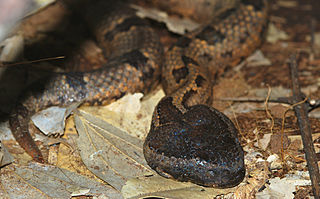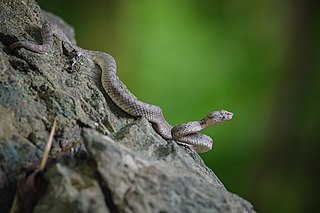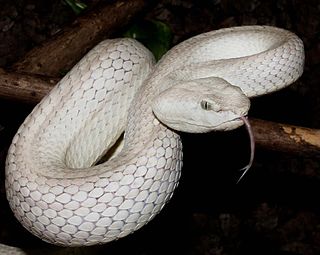
Ovophis monticola, commonly known as the Chinese mountain pit viper, is a venomous pitviper species found in Asia. Currently, two subspecies are recognized, including the nominate subspecies described here. Recent taxonomic work suggests that most of these should be considered as separate species. IUCN has already evaluated O. m. makazayazaya as Ovophis makazayazaya.

Protobothrops mucrosquamatus is a venomous pit viper species endemic to Asia. Common names include: brown-spotted pit viper, Taiwanese habu and pointed-scaled pit viper. No subspecies are currently recognized. The species was first described by Theodore Cantor in 1839.

Trimeresurus albolabris, the white-lipped pit viper or white-lipped tree viper, is a venomous pit viper species endemic to Southeast Asia.
Trimeresurus cantori, commonly known as Cantor's pit viper or Cantor's pitviper, is a species of venomous snake, a pit viper in the Subfamily Crotalinae of the family Viperidae. The species is endemic to the Nicobar Islands of India. It was named after Theodore Edward Cantor (1809-1860), a Danish naturalist serving as a surgeon with the East India Company in Calcutta. No subspecies are recognized as being valid.

Trimeresurus erythrurus, commonly known as the red-tailed bamboo pitviper, redtail bamboo pit viper, and redtail pit viper is a venomous pit viper species found in South Asia and Myanmar. No subspecies are currently recognized.

Craspedocephalus macrolepis, commonly known as the large-scaled pit viper, is a venomous pitviper species endemic to the Southern Western Ghats of South India. No subspecies are currently recognized.

Trimeresurus popeiorum is a species of venomous pit viper in the family Viperidae. The species is native to northern and northeastern parts of India and Southeast Asia. Common names include: Pope's pit viper, Pope's green pit viper, Pope's tree viper and Pope's bamboo pitviper.

Trimeresurus purpureomaculatus is a venomous pit viper species native to India, Bangladesh and Southeast Asia. Common names include: mangrove pit viper, mangrove viper, and shore pit viper.

Trimeresurus stejnegeri is a species of venomous pit viper endemic to Asia. Two subspecies are currently recognized, including the nominate subspecies described here.

Ovophis okinavensis, commonly known as the hime habu (ヒメハブ), Ryukyu Island pit viper, and the Okinawan pitviper, is a venomous pitviper species found in the Ryukyu Islands of Japan. No subspecies are currently recognized.

Trimeresurus kanburiensis is a species of pit viper found in only a few areas of Thailand. Common names include: Kanburi pitviper, Kanburian pit viper, and tiger pit viper. Highly venomous, it is an arboreal but heavily built species with a brown or tawny coloration. No subspecies are currently recognized.

Craspedocephalus puniceus is a venomous pit viper species endemic to Southeast Asia. Common names include: flat-nosed pitviper, flat-nosed pit viper, and ashy pit viper. No subspecies are currently recognized.

Trimeresurus sumatranus is a species of venomous pitviper found in the tropical forests of Indonesia, Malaysia and Thailand. Arboreal by nature, its coloration is pale to neon-green, with some black vertical markings, and a red-tipped tail. As with other vipers, this species has prominent, “keeled” scales, which appear somewhat raised and give the snake a rough-textured appearance. Common names include Sumatran pitviper, Sumatran tree viper, and Sumatran pit viper.

Protobothrops xiangchengensis, commonly known as the Szechwan pit viper, Kham Plateau pitviper, or Sichuan lancehead, is a venomous pit viper species endemic to the Hengduan Mountains in south-central China. No subspecies are currently recognized.
Trimeresurus malcolmi is a venomous pitviper species found in East Malaysia. Common names include: Malcolm's pitviper, Malcolm's tree viper, and Mt. Kinabalu pit viper.
Trimeresurus fasciatus is a venomous pit viper species endemic to Djampea Island, Indonesia. No subspecies are currently recognized. Common names include: banded pitviper and banded tree viper.

Craspedocephalus borneensis, commonly known as the Bornean pit viper, is a venomous pit viper species endemic to the island of Borneo. No subspecies are currently recognized.

Craspedocephalus brongersmai, also known commonly as Brongersma's pit viper, is a species of venomous snake in the subfamily Crotalinae of the family Viperidae. The species is native to islands off the west coast of Sumatra, Indonesia. No subspecies are currently recognized.

Trimeresurus hageni, commonly known as Hagen's pit viper and Hagen's green pit viper, is a species of venomous snake in the subfamily Crotalinae of the family Viperidae. The species is native to Southeast Asia. There are no subspecies that are recognized as being valid.

Trimeresurus mcgregori, commonly known as McGregor's pit viper or the Batanes pit viper, is a species of venomous snake in the subfamily Crotalinae of the family Viperidae. The species is endemic to the Philippines.

















